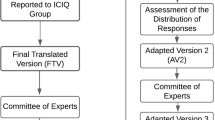Abstract
Introduction and hypothesis
Short questionnaires are important for validating the clinical diagnosis of urinary incontinence (UI). We sought to validate and culturally translate the Questionnaire for Urinary Incontinence Diagnosis (QUID) for the Brazilian Portuguese language.
Methods
A cross-sectional study with 457 women (330 with urinary incontinence and 127 controls) was performed in a Southeastern Brazilian outpatient clinic. Patients answered a pilot-tested, notarized, six-item questionnaire (QUID) for internal consistency as well as a control questionnaire (ICIQ-SF and ICIQ-OAB) for construct validity. In both groups, floor and ceiling effects were calculated. Within UI women, test–retest (n = 41) and responsiveness to conservative treatment (n = 74) were also analyzed.
Results
Internal consistency (Cronbach’s alpha) from the QUID was adequate between the UI (0.845–0.850) and control (0.724–0.775) groups. Mean QUID scores were statistically different between UI and control groups (p < 0.05). No ceiling or floor effects were observed in incontinent patients. Test–retest reliability after 4 weeks (intraclass correlation coefficient [ICC]: 0.780–0.814) and responsiveness (0.867–0.889) were also adequate within UI women. Construct validity was adequate at all correlations between QUID and ICIQ-SF and ICIQ-OAB (r: 0.19–0.58; p <0.05). Responsiveness was demonstrated by a statistically significant difference in questions/subscale sores after physical therapy.
Conclusion
The QUID presented adequate cultural translation, reliability, and good responsiveness to treatment in the Brazilian Portuguese language.
Similar content being viewed by others
References
Haylen BT, De Ridder D, Freeman RM, et al. An International Urogynecological Association (IUGA)/International Continence Society (ICS) joint report on the terminology for female pelvic floor dysfunction. Int Urogynecol J. 2010;21:5–26.
Perera J, Kirthinanda DS, Wijeratne S, Wickramarachchi TK. Descriptive cross-sectional study on prevalence, perceptions, predisposing factors and health seeking behavior of women with stress urinary incontinence. BMC Womens Health. 2014;14:78. https://doi.org/10.1186/1472-6874-14-78.
Tamanini JT, D’Ancona CA, Botega NJ, Rodrigues Netto N Jr. Validation of the Portuguese version of the Kings Health Questionnaire for urinary incontinent women. Rev Saude Publica. 2003;37(2):203–11.
Acquadro C, Kopp Z, Coyne KS, Corcos J, Tubaro A, Choo MS, et al. Translating overactive bladder questionnaires in 14 languages. Urology. 2006;67(3):536–40.
Arouca MA, Duarte TB, Lott DA, et al. Validation and cultural translation for Brazilian Portuguese version of the Pelvic Floor Impact Questionnaire (PFIQ-7) and Pelvic Floor Distress Inventory (PFDI-20). Int Urogynecol J 2016;27(7):1097–1106.
Tamanini JT, Dambros M, D’Ancona CAL, Palma PC, Netto Jr NR. Validation of the International Consultation on Incontinence Questionnaire–Short Form (ICIQ-SF) for Portuguese. Rev Saude Publica. 2004;38(3):438–44.
Bradley CS, Rovner ES, Morgan MA, Berlin M, Novi JM, Shea JA, et al. A new questionnaire for urinary incontinence diagnosis in women: development and testing. Am J Obstet Gynecol. 2005;192(1):66–73.
Srissukho S, Phongnarisorn C, Morakote N. Validation of the Questionnaire for Urinary Incontinence Diagnosis—Thai Version. J Med Assoc Thai. 2018;101(9):1251–4.
Li CY, Zhu L, Lang JH, Xu T, Shi XW. Exploratory and confirmatory factor analyses for testing validity and reliability of the Chinese language questionnaire for urinary incontinence diagnosis. Zhonghua Fu Chan Ke Za Zhi. 2016;51(5):357–60.
Dhillon HK, Zaini ZA, Quek KF, et al. Exploratory and confirmatory factor analyses for testing validity and reliability of the Malay language questionnaire for urinary incontinence diagnosis (QUID). Open J Prev Med. 2014;4(11):844–51.
Treszeamsky AD, Karp D, Dick-Biascoechea M, et al. Spanish translation and validation of four short pelvic floor disorders questionnaires. Int Urogynecol J. 2013;24(4):655–70.
Kottner J, Audige L, Bronrson S. Guidelines for reporting reliability and agreement studies (GRRAS) were proposed. J Clin Epidemiol. 2011;64:96–106. https://doi.org/10.1016/j.clinepi.2010.03.002.
McGraw KO, Wong SP. Forming inferences about some intraclass correlation coefficients. Psychol Method. 1996;1(1):30–46.
Bland JM, Altman DG. Statistical methods for assessing agreement between two methods of clinical measurement. Lancet. 1986;1(8476):307–10.
De Vet HCW, Terwee CB, Mokkink LB, Knol DL. Measurement in medicine. Practical guides to biostatistics and epidemiology, 1st edn. Cambridge: Cambridge University Press; 2011.
Bradley CS, Rahn DD, Nygaard IE, et al. The questionnaire for urinary incontinence diagnosis (QUID): validity and responsiveness to change in women undergoing non-surgical therapies for treatment of stress predominant urinary incontinence. Neurourol Urodyn. 2010;29(5):727–34.
Acknowledgements
The authors thank all patients who have participated in this study, and the Physical Therapy team, at the Women´s Hospital, State University of Campinas (UNICAMP).
Authors’ participation
C.C. Araujo: project development, recruitment, data management, data analysis, manuscript writing, approved the final manuscript; A.A. Marques: project development, recruitment, data management, data analysis, manuscript writing, approved the final manuscript; A Reis: recruitment, data management, approved the final manuscript; L.G.O. Brito: project development, data analysis, manuscript editing, approved the final manuscript; C.R.T. Juliato: project development, data analysis, manuscript editing, approved the final manuscript.
Funding
We are grateful to Coordenação de Aperfeiçoamento Pessoal de Nível Superior (CAPES) for supporting this study with a Post-Graduate Scholarship to one of the authors (CCA), code 001.
Author information
Authors and Affiliations
Corresponding author
Ethics declarations
Conflicts of interest
The authors declare that they have no conflicts of interest.
Additional information
Publisher’s note
Springer Nature remains neutral with regard to jurisdictional claims in published maps and institutional affiliations.
Electronic supplementary material
ESM 1
(DOCX 18.4 kb)
Rights and permissions
About this article
Cite this article
de Araujo, C.C., Juliato, C.R.T., de Andrade Marques, A. et al. Validation and cultural translation for the Brazilian Portuguese version of the Questionnaire for Urinary Incontinence Diagnosis. Int Urogynecol J 32, 3157–3162 (2021). https://doi.org/10.1007/s00192-020-04344-y
Received:
Accepted:
Published:
Issue Date:
DOI: https://doi.org/10.1007/s00192-020-04344-y




